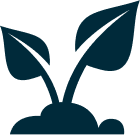Agriculture Drone Services
Benefits of Drone Services in Agriculture
Deveron’s drone services for agriculture provide in-season imagery and analysis for variable rate applications, land management and research programs.
We offer both aerial and satellite imagery options to give you timely and high resolution imagery solutions for you to make actionable decisions throughout the season. Imagery gives you the bigger picture over vast amounts of acres and can help you save time and money.

Timely Imagery

Actionable Insights

Informed Agronomic Decisions
Getting started with Agricultural Drone Services
Providing a Drone’s Eye View, Deveron takes guessing out of agriculture. Our team of professionals use the world’s most advanced unmanned aerial vehicles (UAVs), sensors and software paired with insights to help growers with crop growth staging, field conditions and field health. It can also be used to identify tilling, high/low vegetation, crop disease, insects and more.
Our Drone Services Can Produce RGB or NDVI Maps
RGB
Visual maps used for crop scouting, stand count, crop damage assessment earth works projects, tiling and terracing work.
NDVI
Data rich maps portraying plant health. Used to create management zones and variable rate application prescriptions based on current field conditions.
What can be done with the Drone Imagery?
Variable Rate Prescriptions
Our Normalized Difference Vegetation Index (NDVI) maps highlight variable yield potential in rapidly growing crops. Using NDVI to divide the field into management zones can improve profitability by increasing or decreasing rates where yield potential is high or low, respectively.
Zone Soil Sampling
In-season aerial imagery captures the spatial variation in soil properties that a traditional grid sample will reveal, making it a convenient outline to direct sampling protocols. By delineating management zones from an NDVI map, a number of samples can be pulled from the field while providing equal insight into the actual causes of yield variability.
Winter Wheat Kill Assessment
We are pleased to provide our clients across North America with a tool to determine the implications of Winter Wheat Kill.
How it works
You will receive one data collection through UAV or Drone (remote sensing), plus a Relative Plant Health Map which will help you to determine the percentage of winter wheat kill. This tool is designed to assist growers objectively determine the best financial decisions for their winter wheat, while considering the implications of replanting decisions, nutrient applications, and yield potential.
- We collect a layer of early season UAV imagery to show relative plant health. The imagery is a real-time, high resolution data layer, which can be imported into any precision ag software program
- We create a Relative Plant HealthMap based on information provided in your order. Showing the areas affected by poor plant health and emergence
- You will receive a Plant Health Assessment Map displaying the percentage of winter kill along with the raw data layers
Environmental Stewardship Programs
Managing the landscape surrounding your fields and implementing sustainable solutions is important to maintain a healthy environment. Deveron provides imagery to help monitor retired farmland, grasslands, wild life habitat and ecosystems to ensure best management practices are making a difference in long term sustainability of these ecosystems.
We are proud to be the national verification and project audit provider for ALUS and New Acre™ Project.
Other Agriculture Imagery Options
Satellite
We also use advanced satellite imagery as a supplemental data set for times when Aerial Imagery is not possible due to instances such as unfavourable weather conditions where our drone pilots cannot get out to fly. We offer satellite imagery to collect and analyze intricate data for farmers to make informed decisions, reduce costs and increase their yields.
Agricultural Drone Services FAQs
A: RGB: variety of DJI sensors including Phantom 4 Pro/RTK, Zenmuse P1, and Mavic 3 enterprise
Multispectral: Micasense RedEdge-MX
A: RGB: high-resolution (<1.5cm/pixel) visual colour maps, digital elevation models (DEM), plant stand count, *RTK available
Multispectral: Reflectance maps, vegetation indices (e.g. NDVI), flowering index
A: Client upload utility
Client’s internal-use storage of choice (e.g. SharePoint, Amazon S3)
A: Unprocessed imagery:
- RGB: .JPEG
- Multispectral: .TIF (singleband images)
Processed data:
- RGB: geoTIFF
- Multispectral: geoTIFF
A: No, Deveron also provides satellite imagery for ongoing monitoring, or dates going forward and backward in time.
A: Yes. In most cases this is done using high resolution RGB imagery. Please contact us for more details or to go over your particular request.
A: There are many ways to utilize drone imagery on your farm. Some popular examples include:
- In season crop health evaluation – used to inform nitrogen or fungicide scripts
- Measurement of an area affected by chemical drift, or pest invasion
- Scouting
- Product Applications (Fungicide and Nitrogen)
- Yield Estimation
- Stand Counts (Frost Damage assessments, Winterkill in Wheat, Planter Issues)
- Emergence Issues
- Detecting Equipment issues and or Application issues
- Bare Soil Mapping (land use assessments)
- Boundary Mapping
- Water Management (ex. Levee Assessment)
